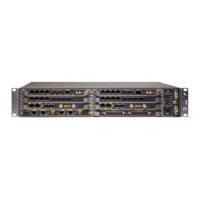Product information and planning
MPR-e 143
Rx side
Following the flow from radio to user Ethernet port, the section performs:
• Reception of the I and Q analog signals coming from the RF section
• Demodulation of the Rx radio frame into the Rx modem frame
• Deframing of the Rx modem frame
• Re-assembly of the fragmented Ethernet frame
• Decompression of the TDMoEth frames header
• Extraction of MPT-HC V2/MPT-XP/9558HC to MPT-HC V2/MPT-XP/9558HC
messages needed for radio link (such as ATPC and ACM)
• Management of service channels frames
• Switching of the management frames from internal processor to user port
• Sending of the recovered clock to the indoor unit
RF section
There are two architectures; the differences between these two architectures are only on the
Rx side:
• For the first one (used in MPT-HC V2/MPT-XP band 7/8 GHz), there are only two
frequency conversions between RF input frequency and baseband frequency
• For the second architecture (used for all other MPT-HC V2/MPT-XP/9558HC
bands), there are three frequency conversions
The block diagrams of these two architectures are shown in Figure 43 and Figure 44.

